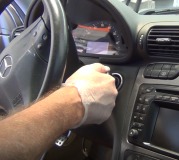Interesting development. Remember from my first reply; you should not have voltage to the coil unless you are cranking the engine, other than that first one second. The voltage comes from the automatic shutdown (ASD) relay. The Engine Computer turns that relay on for one second, then again during engine rotation, (cranking or running). It knows the engine is rotating by the pulses coming from the crankshaft position sensor and the camshaft position sensor.
What surprises me is if you hot-wired the coil, you bypassed the ASD relay. That will send voltage to the coil, injectors, oxygen sensor heaters, and alternator field, but if the computer didn't turn on the relay itself, that means the pulses are missing from one of those sensors. One of them is needed for spark timing and one is used for injector synchronization. When pulses are missing from one of them, the engine normally doesn't run, but that's because all of that stuff is turned off. In your case, it might be running on a backup strategy. The injectors might be firing at the wrong time but that's going to be real hard to notice.
This is too easy, but what might be happening is the ASD relay itself could be bad. Swap it with a different one like it. The starter relay and the AC compressor relay should be the same. Relays don't fail very often, but it's not something to overlook.
If that doesn't help, grab a test light or digital voltmeter and check for voltage at one of the terminals in the ASD relay socket. If you don't find 12 volts on one pin all the time, suspect a blown fuse. It's probably in the under-hood fuse box, but it could also be a fuse link wire that is tied up in the wiring harness. I can't be more specific than that. My background is at a Chrysler dealership. We didn't have many Jeeps come in there.
If a fuse is blown, the two most common causes are an intermittently shorted ignition coil and an oxygen sensor heater wire melted by and touching a hot exhaust pipe. To be safe, you should have a 20 amp fuse inline with any jumper wire you use.
Instead of running off a jumper wire from the battery, you can also jumper the ASD relay. That will connect battery voltage to the ignition coil and injectors just like you're doing now. If your relays are about one inch square, two terminals are parallel to each other and one is on each side. Disregard those and the middle one if it is there. That leaves two that form the letter "T". Those are the two to connect. One of those two is the one that is supposed to have battery voltage all the time. If that doesn't work, that would also suggest there is a blown fuse.
If your relays are the smaller rectangular ones, about one inch by 3/4 inch, there will be three parallel terminals side-by-side. Use the middle one of those three, disregard the fifth one right in the middle of all of them, and use the terminal on the other side. It's turned 90 degrees from those three in a row.
Here's a better idea. Look at the line drawings below. Use terminals 30 and 87, or the two with arrows pointing to 'em.
Caradiodoc
Friday, January 28th, 2011 AT 5:17 AM



